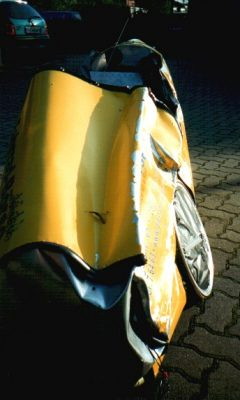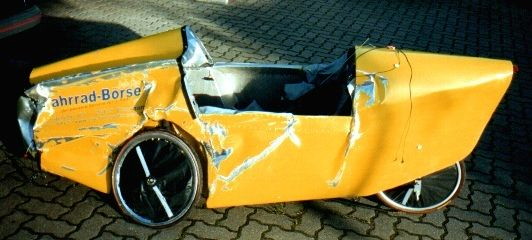It has been some time since I posted anything, not because there has been nothing to write about, rather I have been too busy with other things working on the website back-end. The observant may have noted a few small changes which reflect this, and there is more to come, but more of that later. There are also a couple of posts I am working on that should be up shortly.
 Mean while I thought I would link to this report via BikeBiz on the recent debate on “cycle safety” in the British parliament. It is depressing! It is particularly depressing that so much parliamentary time was wasted going round in circles, seemingly blind to the point, that it is high-speed heavy vehicles that are the danger, not cycling itself, and polystyrene helmets offer NO PROTECTION against such a danger. That blindness, a blindness which kills in an altogether more subtile way, is what makes cyclists/blogosphere/twitersphere so mad.
Mean while I thought I would link to this report via BikeBiz on the recent debate on “cycle safety” in the British parliament. It is depressing! It is particularly depressing that so much parliamentary time was wasted going round in circles, seemingly blind to the point, that it is high-speed heavy vehicles that are the danger, not cycling itself, and polystyrene helmets offer NO PROTECTION against such a danger. That blindness, a blindness which kills in an altogether more subtile way, is what makes cyclists/blogosphere/twitersphere so mad.
The unscientific, irrational, and too often bullying, level of debate is seriously distracting from real solutions to improve on road safety. Technology has become the god of our age. While I am most certainly not anti-technology, I find it very troubling that there is such blind faith in technology, and that the general public are too willing receive the claims that liars marketers make concerning their wares, especially when the wares “might” save the life, say of a child. This faith is dangerously miss-placed. Safety costs! and unfortunately helmets are viewed by too many as a simple and cheap solution. The parody video below and the cartoon at the start highlight, that there are many areas where real safety improvements could be made and, if the arguments of cycle helmet proponents were followed, would require mandatory wearing of PPE.
In an age driven by imagery, icons and what can be seen externally, the idea of a helmet as a guaranteed provider of protection, if not invincibility, is ingrained in the general public. Images of soldiers in bullet proof helmets, construction workers in hard hats, motorcyclists in crash helmets, all of which have saved lives, seem to prove that cycle helmets and compulsion to wear them MUST be a good thing. The following might just change your mind:
A couple of key points from this video:
- Average speed of collision 40 km/h ( mph)
- Maximum speed at which a cycle helmet offers any protection 20 km/h ( mph).
While proponents point to motorcycle helmets and seatbelts, there is a failure to understand the dynamic differences between, the way such safety devices work, and how a cycle helmet is supposed to work. Last night I did a simple experiment and broke a cycle helmet with my bare hands something I could not do to a human skull or a motorcycle helmet. I have made reference before to a cycle accident I was involved in, in 1988, in which a cycle helmet (which I was not wearing) did not save my life! – When I get time and energy I plan on writing up a more detailed account including some technical analysis – In that event my skull exceeded the performance requirements of a cycle helmet!
The “protection” provided by a cycle helmet – vertical impact between 12 & 15 mph – is artificial and highly contrived, you may note from the video above what part of the dummy’s head usually strikes the car, and I am sure many others could confirm the same from their own experience. As my experiment demonstrated a cycle helmet offers next to no protection in the case of side impact. My accident mentioned above was an exception as I hit a vehicle with what was essentially a vertical impact (my face was looking down) at about 20 mph. I have come off my bike a handful of times since, and on no occasion has my head recieved any injury. It should also be noted that the theoretical efficacy of helmets is very much dependent on the proper fitting and attachment of the helmet to the head of the rider. I think it would be safe to say that in most cases, outside of professional cycle sport, helmets are worn incorrectly.
The argument “if it saves a life” is disingenuous. The assumption is that they will do no harm even if they do no good. Evidence is mounting that statistically this is not the case. Thankfully the parliamentary debate attempted to recognize this, as cycling’s health and life benefits far exceed any risks; but also analytically, this assumption is not true. Helmets, like drugs and medicines, have side-effects:
- They make your head bigger – thus increasing the chances of striking or being struck by another object
- They alter the shape of your head – thus altering the natural way your body interacts with its environment – this can affect perception, balance and response in an accident
- They, in most cases, cover your head in an array of convenient grab handles – thus increasing the chances of snagging, leading to the very kind of rotational head and brain injury which results in death or serious life impairment
- They attach a hangman’s noose to your head – a fact tragically illustrated by the 14 documented case where little children died by strangulation while playing wearing a cycle helmet
If it saves 1 life but kills 20 it is not worth it! I recommend reviewing the scientific data available via cyclehelmets.org.
Legal compulsion sends a most unwanted message: generating a false sense of security, to both riders and drivers, leading directly to increased complacency and then injury and death when the “force-field” fails to protect in an accident vehicle incident. It also criminalises, and therefore harms, those who recognize the physical dangers of helmet wearing as well as the limited protection they offer. The comments of Graeme King after the BikeBiz article are very pertinent.



